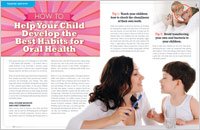
According to the Journal of the American Dental Association, the tongue and lips are the most common sites for intraoral piercings. In either location, the ornament is likely to come into contact with teeth, gum tissue, and other anatomical structures in the mouth. And that’s where the trouble may start.
The Anatomy of a Problem
The tongue, composed primarily of muscle tissue, is rich in blood supply and nerve endings; that’s why a cut on the tongue is often painful and bloody. In a tongue piercing, a metal stud is inserted through a hole made in the tongue. The possibility of infection or the transmission of a blood-borne disease like hepatitis B exists in this situation. Rarely, the piercing may also cause immediate and severe facial pain. It’s the long-term effects of an oral piercing, however, which give the most reason for concern.
As teeth regularly come into contact with the metal parts of the ornament, increased tooth sensitivity and pain may become a problem. Chipping or fracture of the teeth can also occur, which may require tooth restoration. Teeth that have already been restored (with crowns, for example) may be even more prone to damage. Plus, wherever it’s located, jewelry in the mouth can trigger excessive saliva flow, impede speech, and cause problems with chewing and swallowing.
Periodontal (gum) disease can also result from wearing an oral piercing. This may first show up as injury to the soft gum tissue, and later as gum recession. It’s important to understand that before the gums can recede, some of the underlying bone in the jaw must be lost. Following bone loss, inflammation and infection of the gums may occur.
When gums recede, tooth roots become exposed; this makes tooth decay more likely, since roots lack the protective enamel covering of the tooth’s crown. Some studies have even shown that, over time, this condition makes gum disease more likely — primarily because it’s more difficult to practice good oral hygiene with an irregular gum line. Besides causing problems in the mouth, advanced gum disease can have a potentially negative effect on your general (systemic) health.
It’s Your Health — and Your Choice
If you’re old enough to get an oral piercing, you’re old enough to take an active part in maintaining your own oral health. If you are thinking about having a tongue bolt, lip ring, cheek stud, or other ornament placed in your mouth, talk to a dental professional about it first. Due to the increased potential for dental or periodontal problems, you will likely need to have more frequent checkups, and pay special attention to your oral hygiene.
And if the time comes when you decide that the piercing you got on an impulse isn’t what you want any more, take heart: Removing it will immediately reduce your disease risk, and thus instantly improve your oral health!
Related Articles

How to Help Your Child Develop the Best Habits for Oral Health Proper oral health habits are easy to learn — and lead to behaviors that result in lifelong dental health. And the time to begin is as soon as your child’s first baby teeth appear. From toothbrushing for your toddler to helping your teenager stay away from tobacco, Dear Doctor magazine offers the most important tips for healthy habit formation through childhood and beyond… Read Article
